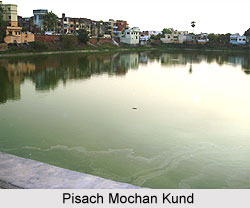 Pisach Mochan Kund located in Varanasi is a famous pilgrimage centre for the devotees. It is situated in the outskirts of the city, on the western side. It has been built in an ordinary way with stone stairs leading down to the water. There are many beautiful temples located here. Many idols have also been installed in these temples. The holy kund is associated with many legends and miracles.
Pisach Mochan Kund located in Varanasi is a famous pilgrimage centre for the devotees. It is situated in the outskirts of the city, on the western side. It has been built in an ordinary way with stone stairs leading down to the water. There are many beautiful temples located here. Many idols have also been installed in these temples. The holy kund is associated with many legends and miracles.
Legend of Pisach Mochan Kund
According to the legend of Pisach Mochan Kund, once a powerful demon approached the holy enclosure in which Varanasi is situated. He was, however, stopped, at the Panch kosi road, by the deities stationed there. They fought with the demon bravely but owing to the great power the demon easily defeated them. He then entered the enclosure and reached the spot where the Pisach Mochan tank is now situated. However, Bhairavnath stopped him there and soon engaged with him in a fierce battle. The battle ended in the former killing the demon and cutting his head. Having performed this act of valour, Bhairavnath conveyed the head to his royal master, Visheswar and stated all the circumstances of the conflict. However, the demon defeated and headless had neither lost his life now his tongue. He went to Visheswar and requested him not to banish him from, the city, but to allow him to reside on the spot where he was decapitated. He also told him that all pilgrims proceeding to the city of Gaya should be directed first to visit him. The king agreed to all his requests and permitted him to reside at that place, but he also added that the demon must take care that no other evil spirit should enter the holy city of Varanasi. This legend is deeply believed by the Hindus.
The head of the demon has been carved in stone and placed on the top of the ghat by the side of one of the temples. The pilgrims visiting the city worship and pay honour Pisach Mochan Kund. Later another Pisach Mochan Kund has been erected in Gaya as a replica of the one existing in Varanasi.
Temples near Pisach Mochan Kund
There are two temples located on the eastern bank of the tank. One of the temples of modem structure was built by Nakku Misr. He served for the Government. The other temple was made by Mirch Bai. The foundation of this temple is very strong while its roof is flat. There are many small shrines located on all the four sides of the temple. Many idols are installed in these shrines. The idol of Lord Shiva is installed here along with the four handed idol of Lord Vishnu. He is seen bearing a conch shell in one hand and a lotus in another. In the third hand he holds a club, and in a fourth a discus. He is adorned with a garland of lotus that hangs from his neck. Goddess Lakshmi, his wife is seated beside him. An image of Lord Brahma has also been installed. Another shrine houses the idol of Lord Hanuman. These idols are installed on one side of the temple. To the other side is the idol of Lord Ganesha. All the remaining sides are similarly decorated with idols of deities. On the west side of the tank there are fewer temples.
Fairs of Pisach Mochan Kund
A very large fair is organised every year at Pisach Mochan kund. It is known as Lota Bhanta. On this day the ritual of grinding the vegetable takes place. It is called bhanta. These are then mixed with flour and made into cakes. These are then eaten at the mela. Many people gather to attend the festival.



















